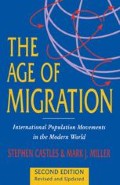Abstract
Since the end of the Second World War, international migrations have grown in volume and changed in character. There have been two main phases. In the first, from 1945 to the early 1970s, the chief economic strategy of large-scale capital was concentration of investment and expansion of production in the existing highly developed countries. As a result, large numbers of migrant workers were drawn from less-developed countries into the fast-expanding industrial areas of Western Europe, North America and Australia. The end of this phase was marked by the ‘oil crisis’ of 1973–4. The ensuing recession gave impetus to a restructuring of the world economy, involving capital investment in new industrial areas, altered patterns of world trade, and introduction of new technologies. The result was a second phase of international migration, starting in the mid-1970s and gaining momentum in the 1980s and 1990s. This phase involved complex new patterns of migration, affecting both old and new receiving countries. This chapter will discuss post-1945 migratory movements to highly developed countries, including Europe, North America and Australia. Labour migration to Japan, which did not become significant until the mid-1980s, will be discussed in Chapter 6, in the context of Asian regional migration.
Preview
Unable to display preview. Download preview PDF.
Copyright information
© 1998 Stephen Castles and Mark J. Miller
About this chapter
Cite this chapter
Castles, S., Miller, M.J. (1998). Migration to Highly Developed Countries since 1945. In: The Age of Migration. Palgrave, London. https://doi.org/10.1007/978-1-349-26846-7_4
Download citation
DOI: https://doi.org/10.1007/978-1-349-26846-7_4
Publisher Name: Palgrave, London
Print ISBN: 978-0-333-73245-8
Online ISBN: 978-1-349-26846-7
eBook Packages: Palgrave Social & Cultural Studies CollectionSocial Sciences (R0)

